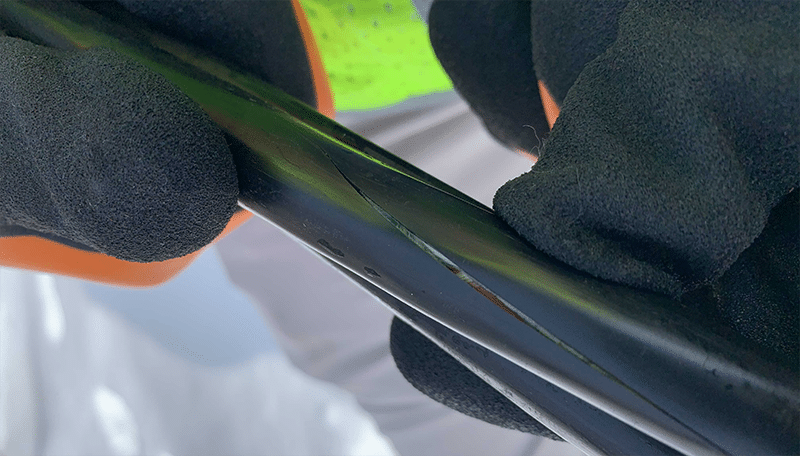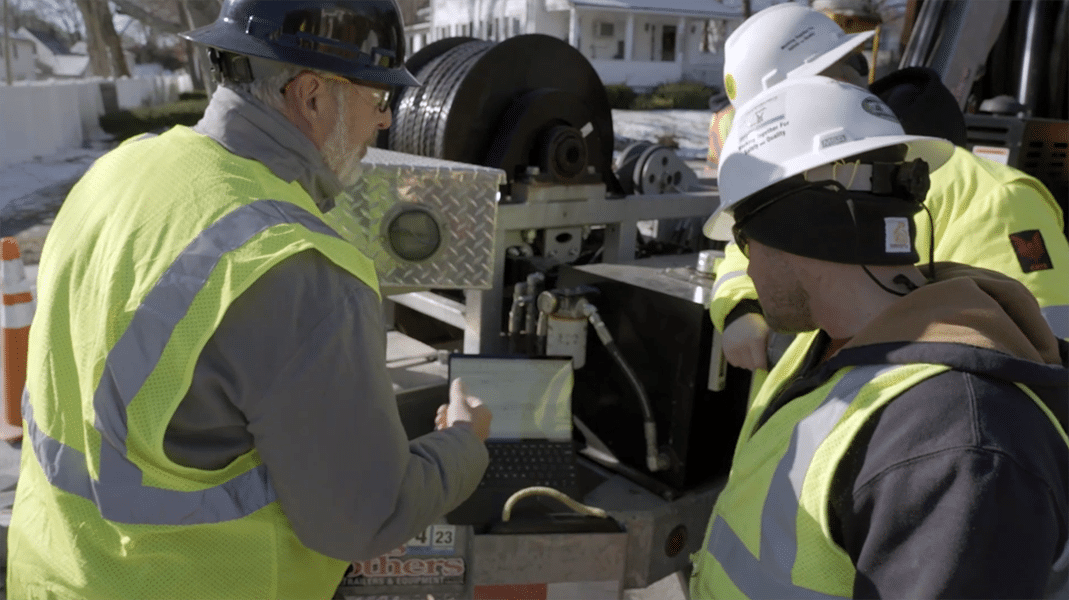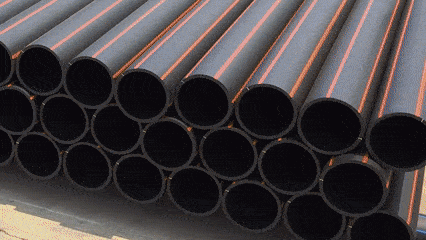Planning Underground Cable-in-Conduit Pulls: Defining a Safety Factor to Maximize Cable Lifespan
Underground cable installations for the transmission or distribution of power or data are essential for creating secure, resilient, and long-lasting infrastructure. As with any construction project, safety is a top priority in undergrounding cable, both for the workers involved and for the longevity of the materials used. Proper planning, especially in the cable pulling phase, is critical to achieving a safe and enduring installation. This article explores how key planning elements and the concept of a "safety factor" can contribute to safer, more effective underground cable installations.
Pull Planning as a Safety Measure
Once an underground cable project is underway, there’s limited flexibility to address issues that arise mid-installation. This makes pull planning essential not only for operational efficiency but also for safety. A thoughtful cable pull plan minimizes the risk of cable damage, reduces costly repairs, and supports the overall functionality and lifespan of the system.
However, even with careful planning, unforeseen damage to cables can still occur. Dynamics like miscommunication between engineers and installers or unaccounted-for site conditions can be at fault. Effective planning incorporates safety measures to mitigate risks where possible.
A Critical Factor in Any Cable Pull Plan: Coefficient of Friction
In pull planning, several factors are known and predetermined, including site layout, conduit material, cable type, and pull distance. However, one critical and often misunderstood factor is the coefficient of friction (COF) between the cable and conduit. COF has a direct relationship to the pulling tension needed to install the cable safely, and it varies based on array of factors but most specifically between the combination of cable, conduit, and lubricant types.
Cable manufacturers provide maximum tension and sidewall pressure to help calculate a benchmark COF value. However, these values are often conservative, set to ensure safe handling of the cable across a variety of installations. Depending on the combination of cable, conduit, and lubricant type, the COF can be much lower than the manufacturer’s numbers. Knowing the actual COF facilitates safe cable handling while maximizing system design. Conversely, accepting a benchmark COF value potentially leads to a one-size-fits-all approach and does not account for other key factors, potentially inviting risk into the pull plan.
Understanding Hidden Cable Damage
Typical underground cable-in-conduit installations feed the cable through a duct using a winch or pulling equipment from the opposite duct end into a vault, manhole, or handhole. It is rare for any cable installation to literally be straightforward. Bends, slopes and angles place stresses on the cable and depending on the cable weight, duct route, and the installation techniques, these stresses can be exacerbated leading to material fatigue. This type of damage can vary greatly depending on the type of cable, affecting cable performance and service life, and may not always be visible.
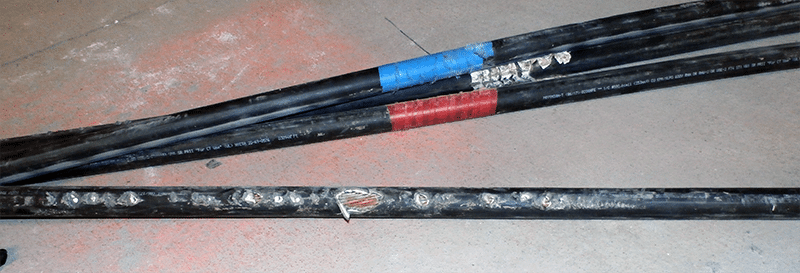
While care can be taken to ensure safe handling of the cable by using lubricants to reduce friction and utilizing the proper machinery and equipment, damage is possible if calculations do not account for actual COF.
Is There a Standard “Safety Factor” in Estimating Cable Pulling Tensions?
There isn’t a single, universally accepted “safety factor” for estimating cable pulling tensions, but applying one is just good engineering and planning.
Planners use industry standards and guidelines when it comes to developing their projects and rely on cable manufacturer’s specifications for the use and limitations of their products. The manufacturer might recommend a conservative benchmark COF of 0.35 or higher to protect cable during installation. Some may rely on this manufacturer’s COF as their “safety factor” when calculating tensions. However, the reliance on a fixed benchmark COF number that is applied to every project is misleading and, in some instances, might be overengineering a cable pull. When it comes to calculating cable pulling tension this is so specific to the project circumstances like the site plan, materials involved, conduit system design, and equipment, that having the same COF benchmark for all projects is like making a standard that all people should wear the same pant size—It doesn’t make sense.
To help with calculating pulling tensions, engineers and installers have relied on planning software. While the software doesn’t provide a safety factor, the use of a software as a tool to model pull feasibility is, in itself, a safety measure.
| Related Content: Data from Polywater® Helps Predict Coefficient of Friction in a Cable Pull |
Pull Planning: A Starting Point for Cable Safety
There are several cable pulling calculation software options available to engineers, planners, and installers. One option teams depend on is the Polywater® Pull-Planner™. It offers valuable support in creating safe and efficient cable installation plans. Here are some unique features that make it a valuable tool:
- Extensive COF Database: The Pull-Planner software includes the world’s largest COF database, allowing users to analyze various combinations of cable, conduit, and lubricant for their project.
- Customizable COF Calculations: By comparing different cable and conduit materials, with or without lubricant, engineers can choose the most suitable options for each project.
- Field Tension Logging: The software lets users record actual field tensions, enabling retroactive calculation of COF for future projects with similar materials and conditions.
- Integration with Manufacturer Specifications: The Pull-Planner incorporates specifications for common cable and conduit types, streamlining the planning process.
- Lubricant Quantities: A recommended lubricant quantity as part of the final pull plan report.
These features make the Pull-Planner more than just a calculator; it’s a tool that contributes to safer installations by allowing for detailed planning that accounts for multiple variables.
| Related Content: The Importance of Pull Direction in Cable Installation |
Tested COF Numbers Are a Good Starting Point
The extensive COF database of the Pull-Planner comes from over forty years of actual lab tested COF data from Polywater, which equates to thousands of miles of cable that has been installed over the past decades with the help of the Pull-Planner™, in all of its various iterations over the years. While field conditions like temperature, moisture, sand and dirt, and pulling equipment influence COF, the database in the software is relied upon by engineers worldwide. For many, the unique COF database of the Pull-Planner is a great starting point for creating plans with more accurate COF values for their cable jacket and conduit material types.
For others, the Pull-Planner COF database provides confidence in creating new possibilities for their cable system design by allowing the planner to model such things as longer cable runs or the elimination of underground structures, which in turn reduce project costs.
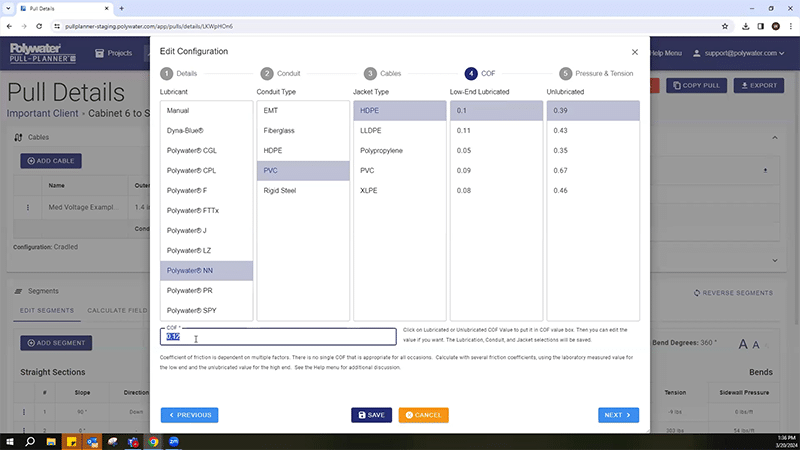
Defining a Safety Factor or Buffer That Is a Multiplier
In engineering fields, like structural and mechanical engineering, there are Factor of Safety (FoS) and Margin of Safety (MoS) equations for equipment, structures, and applications. These typically are a ratio of material strength and allowable stress (or actual capacity and demand value). They function as a way to account for the uncertainty of applied forces to the material properties in the end state or end use of the product that is being constructed. As an example, consider designing an elevator system that can accommodate for more weight than its actual intended use so that it can safely operate in normal and extreme circumstances.
In a way, this is like cable-pulling calculations. The engineer aims to accommodate as many variables as possible in the planning or design stage of a project. To account for this, some planners build in a safety factor or buffer that is based on the maximum limitations provided by cable manufacturers. As mentioned earlier, this can be misleading when applied across all projects that use the same type of cable, as this only accounts for one factor—the cable.
So, how can engineers define a safety factor within a cable pull plan that accounts for uncertain stresses applied to the material properties in a way that is a ratio of the calculated COF?
One thought is to define a safety factor that is a multiplier of the calculated COF. In concept, this could be something like 1.5x to 2.0x the calculated COF. In that way, the safety factor can scale with the different COF values. The question then becomes what should be the multiplying factor? One way to determine this is through past experience and an archive of field-recorded cable-pulling data.
Measuring and Recording Actual Field Tensions
Many engineering and installation teams collaborate to realize safe underground cable installations. One example of this in practice is the measuring and recording of tension during the installation and sharing the results. This data is not only valuable to review alongside the plan but is also valued by the planning engineer who can use this documentation for future cable projects that utilize the same cable and conduit materials as well as conduit system design.
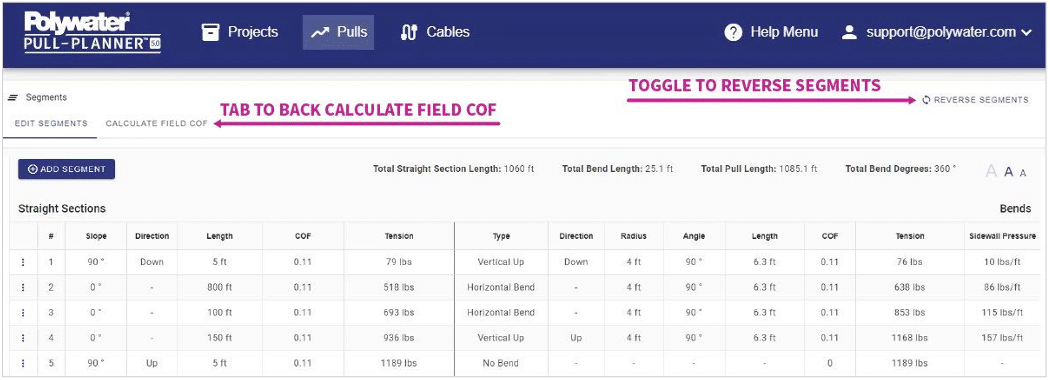
The Polywater Pull-Planner is designed to incorporate and log this field COF data. The function “calculate field COF” allows users to retroactively calculate and analyze the results. Engineers can compare planned COF versus field COF and evaluate any variance. From this they can develop their own custom COF database that is based on their specific cable pulls. The benefits of this process are many and build upon themselves, such as the ability to design and install longer continuous lengths of cable safely, which reduces the required labor and alleviates the need for expensive components like vaults, splice bays, manholes and pull pits.
Knowing the margin of plan COF versus field COF across many similar underground cable installations will give engineers a data set from which they can develop a relevant safety factor.
Conclusion
Effective cable pull planning is crucial for safe and successful underground installations. By incorporating safety factors, understanding variables like the coefficient of friction, and utilizing tools such as the Polywater Pull-Planner™, engineers can anticipate challenges and minimize risks. These precautions not only protect the cable, conduit, and equipment but also extend the lifespan of the entire system. Thoughtful pull planning isn’t just about avoiding immediate installation issues; it’s an investment in the long-term reliability and resilience of electrical and communications infrastructure.

